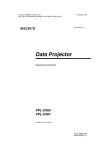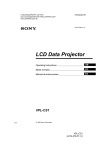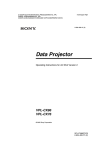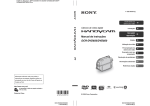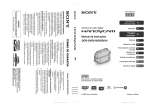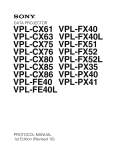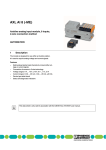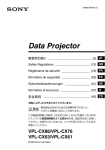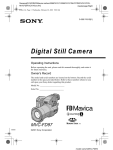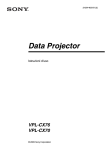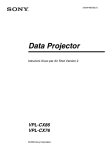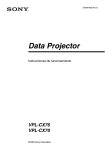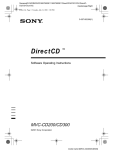Download Sony VPL-CX76 User's Manual
Transcript
masterpage: Right E:\VPL-CX76\2634401121\2634401121VPLCX8676WW\01COV.fm 2-634-401-12 (1) Data Projector Operating Instructions for “Memory Stick” VPL-CX86 VPL-CX76 © 2005 Sony Corporation VPL-CX86/CX76 2-634-401-12 (1) masterpage: Left E:\VPL-CX76\2634401121\2634401121VPLCX8676WW\01COVTOC.fm Table of Contents Overview Features .............................................. 3 Precautions ......................................... 4 About This Manual ............................ 4 About a “Memory Stick” ................... 5 Setting Up Using the “Memory Stick” .............. 10 Operating the Memory Stick Home ............................................ 11 Viewing the Slide Sliding Material for a Presentation — Presentation Viewer ................. 12 Executing the Slide Show Promptly .................................. 13 Switching the File Display Mode ....................................... 13 Repeating the Slide Show .......... 13 Starting a Slide Show from the Selected Index Picture ............ 13 Setting the Autorun Function ..... 13 Sliding a Picture File — Picture Viewer ........................................... 14 Starting a Slide Show from the Selected Index Picture ............ 16 Displaying a Picture File on the Full Screen ...................................... 16 Executing the Slide Show Promptly .................................. 16 Playing Back a Movie File ......... 17 Executing the Slide Show Promptly .................................. 18 Setting/Displaying the Picture File Operating the Picture File .................19 Protecting an Important File .......22 Rotating a Picture File ................22 Registering a File as the Startup Picture ......................................22 Deleting a Picture File ................22 Showing/Hiding the Picture File Information ..............................22 Switching the Sound of a Movie File ...........................................22 Sorting the Picture Files ..............23 Displaying Still Picture Files or Movie Files Only .....................23 Useful Settings Displaying the Picture Files Recorded by a Digital Camera Only .............24 Starting a Presentation Automatically — Autorun ....................................25 Projecting a Selected File When the Power is Turned on— Startup .......26 Operating “Memory Stick” Displaying the “Memory Stick” Information ...................................27 Formatting a “Memory Stick” ..........27 Other Troubleshooting ................................28 2 VPL-CX86/CX76 2-634-401-12 (1) E:\VPL-CX76\2634401121\2634401121VPLCX8676WW\02C01.fm masterpage: Right B Overview Features When the power is turned on, the selected picture file is projected for about 30 seconds. You can adjust the focus and zoom without a signal from other equipment. You can also select the original picture or the registered picture file in the “Memory Stick”. Overview When you memorize presentation material converted by the Projector Station for Presentation (supplied software) or a picture file recorded by a digital camera in the “Memory Stick”, you can easily make effective presentations without a computer. Startup Presentation Viewer After you have converted Microsoft PowerPoint files by the Projector Station for Presentation to a file which offers the most advantages for projection on the projector, you can make a slide show. Picture Viewer You can make the slide show or display on the screen by using a JPEG still picture file (DCF 1)-compatible) recorded by a digital camera and an MPEG1 movie file recorded by Sony MPEG MOVIE etc. You can set the effect of the slide when it is displayed, and the way (automatic or manual) the slide is exchanged. Usable MPEG1 files: MPEG MOVIE, MPEG MOVIE AD, MPEG MOVIE EX, MPEG MOVIE HQ, MPEG MOVIE HQX, MPEG MOVIE CV, MPEG1 of VAIO Giga pocket (equivalent to a Video CD) 1) DCF: Design rules for Camera File systems Digital Camera Mode This unit can choose and display JPEG and MPEG1 picture files recorded by a digital camera (DCF-compatible) only from among picture files stored in a “Memory Stick”. Autorun When the “Memory Stick” with the picture file for which the Autorun function is set by the Projector Station for Presentation or in Memory Stick Home is inserted in the Memory Stick slot, the input is automatically switched to Memory Stick and the slide show starts. Features 3 VPL-CX86/CX76 2-634-401-12 (1) E:\VPL-CX76\2634401121\2634401121VPLCX8676WW\02C01.fm masterpage: Left.L1+L1 Precautions About This Manual • To prevent data loss, make backups of data frequently. In no event will Sony be liable for any loss of data. • Unauthorized recording may be contrary to the provisions of copyright law. • The software may be modified or changed by Sony without prior notice. This manual explains the operations for viewing the picture files stored in the “Memory Stick”. For details on making the presentation material, see the “Operating Instructions of the Projector Station for Presentation” (CDROM, supplied). For operations other than by the “Memory Stick”, see the supplied Operating Instructions. 4 Precautions / About This Manual VPL-CX86/CX76 2-634-401-12 (1) masterpage: Right E:\VPL-CX76\2634401121\2634401121VPLCX8676WW\02C01.fm About a “Memory Stick” “Memory Stick” is a compact-size IC recording medium with a large capacity. It has been designed not only for exchanging/ sharing digital data among “Memory Stick” complaint products, but also for serving as an insertable/removable external storage medium that can save data. “Memory Stick” offers two different sizes: standard size and smaller “Duo” size. “Memory Stick Duo” can become the same size as standard “Memory Stick” by attaching itself to a Memory Stick Duo adaptor, so that it can be also used by products complaint with standard size “Memory Stick”. We also have other types of media available in our line-up. “Memory Stick PRO” and “Memory Stick PRO Duo” have larger storage capacities. • “MagicGate Memory Stick” Equipped with the “MagicGate” copyright protection technology. • “Memory Stick-ROM” “Memory Stick-ROM” stores prerecorded, read-only data. You cannot record on “Memory Stick-ROM” or erase pre-recorded data. • “Memory Stick” (with memory select function) This is a “Memory Stick” that has (128MB) plural memory in it. You can select memory to use for whatever purposes through the memory select switch on the back of the “Memory Stick”. You cannot use all the available memory at the same time and/or continuously. Available types of “Memory Stick” for the projector “Memory Stick” Media Compatibility Chart Recording/ Playback Types of “Memory Stick” “Memory Stick” is available in the following six types to meet various functional requirements. • “Memory Stick Duo” Equipped with the “MagicGate” copyright protection technology and can be used only with “Memory Stick Duo” compliant products. • “Memory Stick” “Memory Stick” stores any type of data except copyright-protected data that requires the “MagicGate” copyright protection technology. • “Memory Stick” (compatible with “MagicGate”/high speed data transfer) Equipped with the “MagicGate” copyright protection and compatible with high speed data transfer. This “Memory Stick” can be used with the “Memory Stick” compliant devices, “MagicGate Memory Stick” compliant devices, and the “Memory Stick PRO” compliant devices*. The projector is not compatible with the high speed data transfer function of this “Memory Stick”. Overview On “Memory Stick” * Operation in all compliant devices are not guaranteed. “Memory Stick” “Memory Stick” (with memory select function) “Memory Stick Duo” “Memory Stick” (compatible with “MagicGate”/high speed data transfer) “Memory Stick Duo” (compatible with “MagicGate”/high speed data transfer) “Memory Stick-ROM” a a*1*2 playback only “MagicGate Memory Stick” “MagicGate Memory Stick Duo” a*1 “Memory Stick PRO” “Memory Stick PRO Duo” a*1*2*3 *1:Data recording/playback that requires “MagicGate” functions cannot be performed. *2:Does not support high speed data transfer using a parallel interface. *3:The projector has been demonstrated as operable with a 1 GB “Memory Stick About a “Memory Stick” 5 VPL-CX86/CX76 2-634-401-12 (1) E:\VPL-CX76\2634401121\2634401121VPLCX8676WW\02C01.fm PRO” manufactured by Sony Corporation. The projector has not been demonstrated as operable with a “Memory Stick PRO” that exceeds 1 GB in capacity. Also, the projector does not support a “Memory Stick PRO” that exceeds 2 GB in capacity. • We do not guarantee the operation of the projector when using a “Memory Stick” or “Memory Stick PRO” manufactured by other manufacturers. • When using a “Memory Stick Duo” in the VPL-CX86, always insert the “Memory Stick Duo” into the Memory Stick Duo adapter sold separately. If you insert a “Memory Stick Duo” without the Memory Stick Duo adapter, you may be unable to remove the “Memory Stick Duo”. Note on “Memory Stick PRO” and “Memory Stick” (compatible with “MagicGate”/high speed data transfer) As to “Memory Stick PRO” and “Memory Stick” (compatible with “MagicGate”/high speed data transfer), the projector does not support high speed data transfer using a parallel interface. Note on “Memory Stick” (compatible with “MagicGate”/high speed data transfer) Transfer speed when using “Memory Stick” (compatible with “MagicGate”/high speed data transfer) varies and is dependent upon “Memory Stick” compliant products. Note on memory capacity of “Memory Stick PRO” “Memory Stick PRO” features vary by and are dependent upon the design of host hardware devices. “Memory Stick PRO” Media slot: The projector • does not support “MagicGate” copyright protection technology. • does not support access control security function. 6 masterpage: Left Note on “Memory Stick Duo”/ “Memory Stick PRO Duo” For VPL-CX86: • To use a “Memory Stick Duo”/“Memory Stick PRO Duo” with this unit, attach it to a Memory Stick Duo adapter before inserting it into the unit. If you insert a “Memory Stick Duo”/ “Memory Stick PRO Duo” without the Memory Stick Duo adapter, you may be unable to remove the “Memory Stick Duo”/“Memory Stick PRO Duo”. • Make sure to attach a “Memory Stick Duo”/“Memory Stick PRO Duo” to the adapter in the right direction. • Make sure to insert a Memory Stick Duo adapter in the right direction. Otherwise, the unit may be damaged. • Do not insert a Memory Stick Duo adapter without a “Memory Stick Duo”/“Memory Stick PRO Duo” attached. Doing so may result in malfunction of the unit. For VPL-CX76: This product has a slot that can take both standard size and Duo size. All the products with such a slot as this is equipped with a system which automatically measures the size of an inserted medium. That's why both standard-size “Memory Stick” and smaller “Memory Stick Duo” can be used on this product without any Memory Stick Duo adaptor. • Do not insert multiple “Memory Sticks” at the same time. It might cause damage to the product. • When you use “Memory Stick Duo” on this product, please make sure to insert it in the right direction. Inserting it in a wrong direction might cause damages to the product. • “Memory Stick Duo” should be kept away from small children to prevent them from accidentally swallowing it. • When you use a “Memory Stick Duo” with this unit, do not attach a Memory Stick Duo adaptor to them. About a “Memory Stick” VPL-CX86/CX76 2-634-401-12 (1) masterpage: Right E:\VPL-CX76\2634401121\2634401121VPLCX8676WW\02C01.fm Available File Capacity This unit is designed to be capable of playing a file with a capacity of less than 2 GB stored in the “Memory Stick”. Data read/write speed may vary depending on the combination of the “Memory Stick” and “Memory Stick” compliant product you use. Note on Access Control This is a function that enables a unique key possessed by each product to protect a “Memory Stick” from being read/written, so that confidential data will not be accessed or erased by other people. This product cannot read/write any data in a “Memory Stick” locked by Access Control of another product. If you need this product to read/write data in such a medium, the medium should be unlocked by the product that locked it. Note on “Memory Stick” (with memory select function) • You cannot use all the available memory at the same time and/or continuously. • Do not use the memory select switch while the “Memory Stick” is connected to any compatible device that is compatible for use with this feature, as this may cause a malfunction. If you use the memory select function while the “Memory Stick” is connected to any compatible device and there is a malfunction, we will not honor the guarantee. • When using the memory select switch, make sure to firmly move the switch to the end. If you do not switch it completely, it may cause a problem or malfunction. • Check your memory selection on “Memory Stick” before inserting it into the Memory Stick slot of the compatible device. • When you use “Memory Stick” with memory select function, you can choose the type of memory by switching the memory select switch. As the compatible device will only access the memory selected by you, note the following: Overview Note on data read/write speed – A formatting (initializing) process is executed for the selected memory only. – Remaining memory display reflects only selected memory information. – Error display reflects only selected memory information. Each memory is handled individually by selecting it. What is “MagicGate”? “MagicGate” is the general name of a copyright protection technology developed by Sony. Format to save a file Material for a presentation converted by the Projector Station for Presentation is saved in the following file formats in the “Memory Stick”. • Image files (DCF-compatible) compressed in the JPEG (Joint Photographic Experts Group) format (extension.jpg). • The Sony Projector Presentation file (SPP file), which is an original file format of Sony. This file integrates information such as destination and setting information of the image file, etc. Before using a “Memory Stick” Terminal Writeprotect tab Labeling position • When you set the “Memory Stick” erasure prevention switch to Lock, data cannot be recorded, edited, or erased. * Some “Memory Stick” (“Memory Stick Duo”) are not equipped with an erasure prevention switch. When using a “Memory Stick” without an erasure prevention switch, be careful not to edit or erase data by mistake. • Use a sharp object, such as a ballpoint pen, to move the “Memory Stick Duo”/ Memory Stick PRO Duo erasure prevention switch. About a “Memory Stick” 7 VPL-CX86/CX76 2-634-401-12 (1) E:\VPL-CX76\2634401121\2634401121VPLCX8676WW\02C01.fm • Data may be damaged if: – You remove the “Memory Stick” or turn off the unit while it is reading or writing data. – You use the “Memory Stick” in a location subject to the effects of static electricity or electric noise. • We recommend that you make a backup copy of important data that you record on “Memory Stick”. Notes • Do not attach anything other than the supplied label to the “Memory Stick” labeling position. • Attach the label so that it does not stick out beyond the labeling position. • Do not write forcefully on “Memory Stick Duo”/Memory Stick Duo memo area. • Carry and store the “Memory Stick” in its case. • Do not touch the terminal of the “Memory Stick” with anything, including your finger or metallic objects. • Does not strike, bend, or drop the “Memory Stick”. • Do not disassemble or modify the “Memory Stick”. • Do not allow the “Memory Stick” to get wet. • Do not use or store the “Memory Stick” in a location that is: – Extremely hot, such as in a car parked in the sun – Under direct sunlight – Very humid or subject to corrosive substances About formatting “Memory Stick” When “Memory Stick” are shipped from the factory, they are already formatted to a special standard. When you format “Memory Stick”, we recommend formatting them on this unit. Caution when formatting “Memory Stick”s on a personal computer Pay attention to the following points when formatting “Memory Stick” on a personal computer. Operation of “Memory Stick” formatted on a personal computer is not guaranteed on 8 masterpage: Left this unit. To use a “Memory Stick” that has been formatted on a personal computer, the “Memory Stick” must be reformatted on this unit. If it is not reformatted, all data stored on “Memory Stick” will be lost. Notes on image data compatibility Image data files saved to a “Memory Stick” by using the software conforming to the Design Rules for Camera File Systems universal standard established by JEITA (Japan Electronics and Information Technology Industries Association). JPEG files converted by Adobe Photoshop, etc. must be converted to JPEG format (DCF-compatible) again by the Projector Station for Presentation. Access Lamp If the access lamp is turned on or is flashing, data is being read from or written to the “Memory Stick”. At this time, do not shake the computer or projector or subject them to shock. Do not turn off the power of the computer and projector or remove the “Memory Stick”. This may damage the data. About Trademarks • Microsoft and PowerPoint are registered trademarks and trademarks of Microsoft Corporation in the United States and/or other countries. • Adobe and Photoshop are either registered trademarks or trademarks of Adobe Systems Incorporated in the United States and /or other countries. • Compact Flash is a trademark of the SanDisk Corporation in the United States. • VAIO is trademark of Sony Corporation. • “Memory Stick” and are trademarks of Sony Corporation. • “Memory Stick Duo” and are trademarks of Sony Corporation. • “Memory Stick PRO” and are trademarks of Sony Corporation. • “Memory Stick PRO Duo” and are trademarks of Sony Corporation. About a “Memory Stick” VPL-CX86/CX76 2-634-401-12 (1) E:\VPL-CX76\2634401121\2634401121VPLCX8676WW\02C01.fm masterpage: Right Overview • “Memory Stick-ROM” and are trademarks of Sony Corporation. • “MagicGate Memory Stick” is trademark of Sony Corporation. • “MagicGate” and are trademarks of Sony Corporation. About a “Memory Stick” 9 VPL-CX86/CX76 2-634-401-12 (1) E:\VPL-CX76\2634401121\2634401121VPLCX8676WW\03C02.fm masterpage: Left B Setting Up Using the “Memory Stick” To remove the “Memory Stick” When the access lamp is turned off, press the “Memory Stick” and remove your hand. As the lock is released, remove the “Memory Stick”. Insert the “Memory Stick” into the Memory Stick slot on the side of the projector until it clicks. For VPL-CX86 Access lamp “Memory Stick” Insert the “Memory Stick” in the direction of the arrow. For VPL-CX76 Access lamp “Memory Stick” Notes • Insert the “Memory Stick” with the arrow mark pointing toward the Memory Stick slot. • Do not insert the “Memory Stick” into the wireless LAN card slot. • You cannot insert the “Memory Stick” into the wireless LAN card slot even if you use the Memory Stick Duo adapter compliant with the Compact Flash slot. • A “Memory Stick” inserted into the Memory Stick slot on the projector cannot be accessed from the Projector Station for Presentation. 10 Using the “Memory Stick” VPL-CX86/CX76 2-634-401-12 (1) E:\VPL-CX76\2634401121\2634401121VPLCX8676WW\03C02.fm Operating the Memory Stick Home 3 masterpage: Right Use the M or m key to make the setting for an item, then press the ENTER key. Setting Up The initial display for “Memory Stick” input is the Memory Stick Home. The Memory Stick Home is used for setting and executing an event (e.g., selecting the viewer), setting the Autorun and Startup and formatting the “Memory Stick”. The guide for the key operation is displayed at the bottom of the Memory Stick Home display. Use the Remote Commander or the control panel for setting. The selected item is displayed in yellow. For details on each operation, see the relevant page. 1 Press the Stick”. key to select “Memory The Memory Stick Home appears. Memory Stick Home mark Title or folder name for the selected contents 2 First picture file of the selected content Use the M or m key to select the desired item, then press the ENTER key. Operating the Memory Stick Home 11 VPL-CX86/CX76 2-634-401-12 (1) E:\VPL-CX76\2634401121\2634401121VPLCX8676WW\04C03.fm masterpage: Left B Viewing the Slide Sliding Material for a Presentation — Presentation Viewer 3 Select “Presentation Viewer”, then press the ENTER key. 4 Select “Select Folder”, then press the ENTER key. The Select Folder menu appears. After you have converted Microsoft PowerPoint files by the Projector Station for Presentation to a file which offers the most advantages for projection on the projector, you can make a slide show. For details on making the presentation material, see the Operating Instructions of the Projector Station for Presentation (CDROM, supplied). 1 Press the Stick”. The Presentation Viewer can select the “contents” in units of a folder in which multiple JPEG files are contained. In the above illustration, there are three lots of contents of presentation material: Presentation 1, Presentation 2 and Presentation 3. key to select “Memory The Memory Stick Home appears. To select the contents which are not displayed, press the , key to select the slider in the Select Folder menu and press the m or M key. The next three lots of contents appear. 5 2 Select “Select”, then press the ENTER key. A drop-down list appears. 12 Select the contents for the presentation, then press the ENTER key. The title name of the selected presentation material and the first picture file is displayed. Sliding Material for a Presentation — Presentation Viewer VPL-CX86/CX76 2-634-401-12 (1) E:\VPL-CX76\2634401121\2634401121VPLCX8676WW\04C03.fm 6 Select “Slide Show”, then press the ENTER key. 7 Select “Start”, then press the ENTER key. 1 Select “Index Display” in Memory Stick Home, then press the ENTER key. 2 Select the setting, then press the ENTER key. To execute the slide show Normal: to display a picture file Thumbnail: to display thumbnails of the picture files contained in the selected contents Repeating the Slide Show 1 Select “Slide Show” in Memory Stick Home, then press the ENTER key. 2 Select “Repeat”, then press the ENTER key. On: to execute the slide show repeatedly Off: to execute the slide show one time only To return to Memory Stick Home before executing the slide show Select “Close” to return to Memory Stick Home before executing the slide show in Step 6 of “Sliding Material for a Presentation — Presentation Viewer.” Executing the Slide Show Promptly As the settings are memorized even if you change the input after the setting of steps 1 to 5 of “Sliding Material for a Presentation — Presentation Viewer,” press the key on the Remote Commander just as you start the presentation. The input is changed to “Memory Stick”. Press the key again and the slide show starts promptly. To end the slide show, press the or ENTER key when the slide show setting is “Auto”, or press the key when the slide show setting is “Manual.” Switching the File Display Mode You can display one picture file only (Normal mode) or thumbnails of picture files (Thumbnail mode). Viewing the Slide When you create presentation material using Projector Station for Presentation, if the slide show setting is set to “Auto”, the slide show is executed according to the settings made by the Projector Station for Presentation. When you want to end the slide show, press the or ENTER key. If the slide show setting is set to “Manual,” press the following keys for the slide show. , : to display the next slide < : to display the previous slide : to end the slide show masterpage: Right Starting a Slide Show from the Selected Index Picture You can run a slide show by selecting a thumbnail in the normal or thumbnail display mode. 1 Press the M, m, < or , key to select the picture file from which you want to start the slide show, and press the ENTER key. 2 Press the M or m key to select “Slide Show” in the picture setting menu, and press the ENTER key. Setting the Autorun Function When you store the presentation file for which the Autorun function is set in the “Memory Stick” and insert it in the Memory Stick slot on the projector, the input channel is automatically switched to “Memory Stick” and the slide show starts. 1 Select the title of the file you want to use for your presentation in Memory Sliding Material for a Presentation — Presentation Viewer 13 VPL-CX86/CX76 2-634-401-12 (1) masterpage: Left E:\VPL-CX76\2634401121\2634401121VPLCX8676WW\04C03.fm Stick Home, then press the ENTER key. 2 Select “Autorun”, then press the ENTER key. Sliding a Picture File — Picture Viewer You can make a slide show by using still picture files (DCF-compatible) in the JPEG format recorded by a digital camera or movie picture files in the MPEG1 format recorded by Sony MPEG MOVIE etc. For details on operations regarding the picture files, see “Operating the Picture File” on page 19. 1 Press the key to select the “Memory Stick”. Memory Stick Home appears. 3 Select the item you want to set, then press the ENTER key. Set: to set the Autorun function for the file Cancel: to cancel the Autorun function of the file Close: when you do not set the Autorun function for the file Notes • You can set the Autorun function for only one presentation file per “Memory Stick”. • To use the Autorun function, set “Autorun” to “On” as described in “Starting a Presentation Automatically — Autorun” on page 25. 14 2 Select “Select”, then press the ENTER key. A drop-down list appears. Sliding a Picture File — Picture Viewer VPL-CX86/CX76 2-634-401-12 (1) E:\VPL-CX76\2634401121\2634401121VPLCX8676WW\04C03.fm 3 Select “Picture Viewer”, then press the ENTER key. Select the current folder using the m or M key, then press the , key to select the Select Folder menu. 6 Select the folder for your presentation, then press the ENTER key. 4 The title name and the first picture file of the selected folder are displayed. To select the folders which are not displayed, press the , key to select the slider in the Select Folders menu and press the m or M key. The next 10 folders appear. Select “Select Folder”, then press the ENTER key. The Select Folder menu appears. Folders included in the current folder Current folder To upper stage First picture file in the current folder 7 Viewing the Slide 5 Thumbnails of the picture files contained in the selected folder appear. : Appears when a file is protected. : Appears when a startup file is set. : Movie icon masterpage: Right Select “Slide Show” in Memory Stick Home, then press the ENTER key. Effect: to set the effect when the slide is displayed Advan. Slds.: to set automatic or manual slide Interval: to set the period for which one slide is displayed The time is approximate. When “Advan. Slds.” is set to “Manual”, it does not work. Repeat: to execute the slide show repeatedly or one time only Sliding a Picture File — Picture Viewer 15 VPL-CX86/CX76 2-634-401-12 (1) E:\VPL-CX76\2634401121\2634401121VPLCX8676WW\04C03.fm 8 Select each item, then press the ENTER key. 9 Set each item, then press the ENTER key. 10 Select “Start”, then press the ENTER key. 2 When “Advan. Slds.” is set to “Manual”, the movie is not played back and the first picture is displayed for a movie file. By pressing the , key the next slide is displayed. To play back the movie, see “Playing Back a Movie File” on page 17. To return to Memory Stick Home before executing the slide show Select “Close” to return to Memory Stick Home before executing the slide show in Step 10 of “Sliding a Picture File — Picture Viewer” (see page 14) Starting a Slide Show from the Selected Index Picture You can run a slide show by selecting a thumbnail in the normal or thumbnail display mode. 1 16 Press the M, m, < or , key to select the picture file from which you want to start the slide show, and press the ENTER key. Press the m or M key to select “Slide Show” in the picture setting menu, and press the ENTER key. Displaying a Picture File on the Full Screen 1 Select a picture file in the thumbnail display, then press the ENTER key. 2 Select “Full Screen”, then press the ENTER key. To execute the slide show When “Advan. Slds.” in the slide show setting is set to “Auto”, the slides change automatically. When a movie file is selected, the movie plays back automatically, and after playback the next slide is displayed automatically. When you want to end the slide show, press the or ENTER key. When it is set to “Manual”, press the following keys for the slide show. , : to display the next slide < : to display the previous slide : to end the slide show masterpage: Left The selected picture file is enlarged on the full screen. To execute the slide show with the picture on the full screen Press the following keys. , : to display slides forward (The slide show ends at the last picture file.) < : to display slides backward (The slide show ends at the first picture file.) : to return to Memory Stick Home Executing the Slide Show Promptly As the settings are memorized even if you change the input after the setting of steps 1 to 9 of “Sliding a Picture File — Picture Viewer”, press the key on the Remote Commander just as you start the presentation. The input is changed to “Memory Stick”. Press the key again and the slide show starts promptly. To end the slide show, press the or ENTER key when “Advan. Slds.” is set to “Auto”, or Sliding a Picture File — Picture Viewer VPL-CX86/CX76 2-634-401-12 (1) E:\VPL-CX76\2634401121\2634401121VPLCX8676WW\04C03.fm press the key when “Advan. Slds.” is set to “Manual”. Playing Back a Movie File You can play back a movie using the Movie Player displayed on the screen when “Advan. Slds.” is set to “Manual”. You can also start movie playback by selecting a movie file in the thumbnail display mode. masterpage: Right When a movie file is selected by pressing the < or , key, the Movie Player appears on the screen. Operate the Movie Player as follows: [Movie Player] Notes 1 Follow steps 1 to 7 of “Sliding a Picture File — Picture Viewer”. 2 Set “Advan. Slds.” to “Manual” in the Slide Show setting menu. N (play/pause) : to play back. During playback, the button display is changed to the X (pause) button. x (stop) : to stop playback Full Screen : to play back on the full screen Menu : to display the index screen Viewing the Slide • The Movie Player cannot be displayed when “Advan. Slds.” is set to “Auto”. • The unit can play back an MPEG1 movie file recorded by the Sony MPEG MOVIE, etc. (Movies may occasionally skip when you watch them.) Usable MPEG1 files: MPEG MOVIE AD/ EX/HQ/HQX/CV, MPEG1 of VAIO Giga pocket (equivalent to a video CD). [Guide display] < Prev. : to display the previous slide in the movie pause mode. During playback, the guide display is changed to < Rew (rewind). , Next : to display the next slide in the movie pause mode. During playback, the guide display is changed to , FF (fast forward). To play back a movie 3 Press the ENTER key. 4 Select “Start”, then press the ENTER key. Press N. Playback starts. When the playback is finished, playback stops with the first picture of the movie file displayed. To stop the playback momentarily, press the m key to select x, then press the ENTER key. To play back on the full screen To execute the slide show Press the following keys: , : to display the next slide < : to display the previous slide : to end the slide show Select “Full Screen”, then press the ENTER key. The picture is enlarged on the full screen and playback starts. Sliding a Picture File — Picture Viewer 17 VPL-CX86/CX76 2-634-401-12 (1) E:\VPL-CX76\2634401121\2634401121VPLCX8676WW\04C03.fm When you press the M, m, <, , or ENTER key during playback, the Movie Player reappears on the screen. masterpage: Left For details on operations of the index screen, see “Operating the Picture File” on page 19. Note When the picture size is small, it is not enlarged on the full screen if you select “Full Screen”. To return to Memory Stick Home without executing the movie play Select “Return”. Executing the Slide Show Promptly As the settings are memorized even if you change the input after the setting of steps 1 to 3 of “Playing Back a Movie File”, press the key on the Remote Commander just as you start the presentation. The input is changed to “Memory Stick”. Press the key again and the slide show starts promptly. To end the slide show, press the key. To start full-screen playback when the thumbnails are displayed 1 Select a movie file, then press the ENTER key. The index screen appears (see page 20). 2 Select “Movie Player”, then press the ENTER key. The Movie Player appears. 3 Select “Full Screen”, then press the ENTER key. Playback starts automatically. To operate the movie file Select “Menu” in the Movie Player, then press the ENTER key. The index screen is displayed. Using the index screen, you can show or hide the movie file information, switch the sound, protect important movie files, or delete unnecessary movie files. 18 Sliding a Picture File — Picture Viewer VPL-CX86/CX76 2-634-401-12 (1) E:\VPL-CX76\2634401121\2634401121VPLCX8676WW\05C04.fm masterpage: Right B Setting/Displaying the Picture File Operating the Picture File To operate the picture file, display the index screen (see page 20 and page 21). When the Presentation Viewer is displayed To display the index screen, select the contents in the normal or thumbnail display mode, then press the ENTER key. You can execute the slide show or enlarge a picture file on the full screen using the menu on the index screen. If you press the ENTER key when a full-screen picture is displayed, you can show or hide the picture file information. When the Picture Viewer is displayed When a movie file (Movie Player) is selected To display the index screen, select “Menu” on the Movie Player. You can perform the following operations using the menu on the index screen: showing/hiding the movie file information, switching the sound, protecting an important movie file and deleting a movie file. For details on the use of the index screen, see the relevant page. Notes You cannot switch the sound of a Movie File in the following cases: • When the audio sampling rate is incompatible. • When the audio recording mode is monaural. • When the audio recording mode is incompatible. Setting/Displaying the Picture File The possible operations depend on the type of picture file to be selected (still picture/ movie). When “Thumbnail” is selected for “Index Display” To display the index screen, select a thumbnail, then press the ENTER key. You can perform the following operations using the menu on the index screen: displaying a picture file on the full screen, executing a slide show, protecting an important picture file, rotating a picture file (still picture only), registering the startup picture file (still picture only) and deleting a picture file. When a full-screen still picture file is selected To display the index screen, press the ENTER key when the picture is displayed on the full screen. You can perform the following operations using the menu on the index screen: showing/hiding the picture file information, protecting an important picture file, rotating a picture file, registering the startup picture file and deleting a picture file. Operating the Picture File 19 VPL-CX86/CX76 2-634-401-12 (1) masterpage: Left E:\VPL-CX76\2634401121\2634401121VPLCX8676WW\05C04.fm Index screen of a still picture file Index screen Appears when a startup file is set. Appears when a file is protected. Appears when the Picture Viewer is displayed. Index screen of a movie file Appears for a movie picture. Appears when a file is protected. Index screen Movie Player Slide Show Protect Full Screen Rotate Slide Show Startup Protect Delete Rotate Startup Close Delete Close Resolution Resolution Order of the current content Date Total number of picture files in the current content File name and file format Order of the current content Date Total number of picture files in the current content File name and file format To select a picture file in the thumbnail display mode, press the M, m, < or , key. If you want to display other picture files when more than 16 picture files are contained in the current content, select a picture file displayed in the bottom row and press the m key, or select a picture file displayed in the right-most column, press the , key to select the slider, then press the m key. To start the slide show, press the key in the index screen. The slide show begins from the selected picture file. 20 Operating the Picture File VPL-CX86/CX76 2-634-401-12 (1) masterpage: Right E:\VPL-CX76\2634401121\2634401121VPLCX8676WW\05C04.fm Index screen of a full-screen still picture file Movie Player Movie icon Appears when the Picture Viewer is displayed. Order of the current content/ Total number of picture files in the current content Resolution Date Order of the current content/ Total number of picture files in the current content Resolution Appears when a startup file is set. File name and file format Date File name and file format Appears when a file is protected. Setting/Displaying the Picture File Appears when a file is protected. If you want to display another picture file when multiple picture files are contained in the current content, press the , key. To return to Memory Stick Home, press the key in the index full screen. Operating the Picture File 21 VPL-CX86/CX76 2-634-401-12 (1) masterpage: Left E:\VPL-CX76\2634401121\2634401121VPLCX8676WW\05C04.fm Protecting an Important File After selecting the file you want to protect, set “Protect” to “On” or “All On”. When a file is protected, the protect mark is displayed. 1 Select “Delete”, then press the ENTER key. 2 Select an item. When “Selected file deleted. OK?” or “All files deleted. OK?” is displayed, select “Yes”, then press the ENTER key. All Img. : to delete all picture files of the selected contents Sel. Img. : to delete the selected picture file Close : when you do not want to delete the file Rotating a Picture File After selecting the file you want to rotate, set “Rotate”. The picture rotates 90° on every pressing of the ENTER key. Note A protected file cannot be rotated. Note A protected file cannot be deleted. Registering a File as the Startup Picture You can register a picture file in the “Memory Stick” as the startup picture file which is displayed when the power is turned on. Set “Startup” to “Entry”. When the file is registered, the startup mark is displayed. When you want to use the registered picture file as the startup file, set “Startup” of the Setting screen to “Custom” (see page 26). To cancel the registration of the startup picture 1 Display the picture setting menu by selecting a thumbnail, select “Startup,” and press the ENTER key. 2 Press the m or M key to select “Cancel,” and press the ENTER key. Note As the setting of “Custom” is memorized in the “Memory Stick”, when you want to use the registered picture file as the startup file, insert the “Memory Stick” in the projector before turning on the projector. Deleting a Picture File You can delete the selected picture file or all picture files of the selected contents. 22 Showing/Hiding the Picture File Information Select a picture file, select “Information” in “Menu” on the index screen of the fullscreen still picture or on the Movie Player, then press the ENTER key. When you want to display the picture file information, select “On”. The information is displayed at the bottom of the screen. If you do not want to display the information, select “Off”. When the Presentation Viewer is displayed, the number and size (resolution) of the picture file are displayed. When the Picture Viewer is displayed, the number, size (resolution), file format and recorded date of the picture file are displayed. Note For a picture file processed on a computer, the renewal date may be displayed instead of the recorded date. Switching the Sound of a Movie File 1 Select a movie file, then press the ENTER key. 2 Select “Movie Player,” then press the ENTER key. Operating the Picture File VPL-CX86/CX76 2-634-401-12 (1) E:\VPL-CX76\2634401121\2634401121VPLCX8676WW\05C04.fm 3 Select “Menu,” then press the ENTER key. 4 Select “Audio Select,” then press the ENTER key. L/R : to hear the left and right sounds L : to hear the left sound R : to hear the right sound masterpage: Right Displaying Still Picture Files or Movie Files Only You can filter all picture files contained in a folder to display the still picture files or the movie files only. 1 Select “Option” in Memory Stick Home, then press the ENTER key. 2 Select “File”, then press the , or ENTER key. 3 Select “Filter”, then press the ENTER key. 4 Select the item you want to set, then press the ENTER key. Notes You cannot switch the sound of a Movie File in the following cases: • When the audio sampling rate is incompatible. • When the audio recording mode is monaural. • When the audio recording mode is incompatible. Sorting the Picture Files 1 Select “Option” in Memory Stick Home, then press the ENTER key. 2 Select “File”, then press the , or ENTER key. 3 Select “Sort”, then press the ENTER key. 4 Select the item you want to set, then press the ENTER key. Still : to display still pictures only Movie : to display movie files only Off : to display all files without filtering Note When the filter is set, the current filter name (Still or Movie) is displayed at the bottom right of Memory Stick Home. Setting/Displaying the Picture File You can sort the picture files in a folder by name or by renewal date in ascending/ descending order. Notes • For a picture file processed on a computer, the displayed data may be different from the renewal date. • When “Digi Camera Mode” is set to “ON,” you can not sort the picture files. For details on “Displaying the Picture Files Recorded by a Digital Camera Only” on page 24. Operating the Picture File 23 VPL-CX86/CX76 2-634-401-12 (1) E:\VPL-CX76\2634401121\2634401121VPLCX8676WW\06C05.fm masterpage: Left B Useful Settings Displaying the Picture Files Recorded by a Digital Camera Only The unit can choose and display the JPEG and MPEG1 picture files recorded by a digital camera (DCF-compatible) only from among picture files stored in a “Memory Stick”. 1 Select “Select Folder” in Memory Stick Home, then press the ENTER key. 2 Select “Digi. Camera Mode”, then press the ENTER key. 3 Select “On”, then press the ENTER key. last four characters is stored in the “Memory Stick”. Notes • This function does not work if more than 4000 picture files recorded by a digital camera are stored in a “Memory Stick”. • For a picture file recorded with the Voice Memo function of a Sony digital camera, the still picture file is displayed only. • If you delete a picture file with the relative file mark ( ), its related picture file will also be deleted. (Relative file mark): Appears if another file with the same name in the 24 Displaying the Picture Files Recorded by a Digital Camera Only VPL-CX86/CX76 2-634-401-12 (1) E:\VPL-CX76\2634401121\2634401121VPLCX8676WW\06C05.fm masterpage: Right slide show even if you set “Autorun” to “On” in Memory Stick Home. • When you want to use the autorun function for a picture file in the JPEG format, make the presentation material with the Projector Station for Presentation and set the autorun function to “On”. Starting a Presentation Automatically — Autorun When a “Memory Stick” with the picture file for which the Autorun function is set by the Projector Station for Presentation or “Setting the Autorun Function” on page 13 is inserted in Memory Stick slot, the input is automatically switched to “Memory Stick” and the slide show starts. To set the Autorun function Select “Option” in Memory Stick Home, then press the ENTER key. 2 Select “Setting”, then press the ENTER key. 3 Select “Autorun”, then press the ENTER key. 4 Select “On”, then press the ENTER key. Useful Settings 1 When you do not want to use the autorun function Set “Autorun” to “Off”. Notes • When the autorun is not set to “On” by the Projector Station for Presentation or “Setting the Autorun Function” on page 13, you cannot use the autorun function to start the Starting a Presentation Automatically — Autorun 25 VPL-CX86/CX76 2-634-401-12 (1) E:\VPL-CX76\2634401121\2634401121VPLCX8676WW\06C05.fm Projecting a Selected File When the Power is Turned on — Startup masterpage: Left Off : when you do not want to set the startup Notes • When you want to use the registered file with the custom setting, insert the “Memory Stick” where the registered file is saved in the projector, then turn on the power. • You can register one startup file per “Memory Stick”. When the power is turned on, the selected picture file is projected for about 30 seconds. When you want to use the registered picture file as the startup file, you must register a picture file as the startup file in the index screen (see page 22). When a picture file whose resolution is larger than XGA (1024×768) is registered, a startup file may not be displayed correctly. 1 Select “Option” in Memory Stick Home, then press the ENTER key. 2 Select “Setting”, then press the , or ENTER key. 3 Select “Startup”, then press the ENTER key. 4 Select the item, then press the ENTER key. Original : to select the original picture memorized in the projector. The original picture cannot be changed. Custom : to select the picture file registered in the index screen which is saved in “Memory Stick” 26 Projecting a Selected File When the Power is Turned on — Startup VPL-CX86/CX76 2-634-401-12 (1) masterpage: Right E:\VPL-CX76\2634401121\2634401121VPLCX8676WW\07C06.fm B Operating “Memory Stick” Displaying the “Memory Stick” Information You can display the type and the used and remaining capacity of the “Memory Stick” in use. The remaining capacity of the “Memory Stick” is also displayed at the bottom right of Memory Stick Home. Formatting a “Memory Stick” When a “Memory Stick” cannot be used, format it with the projector. When a “Memory Stick” is formatted, its data is cleared. 1 Select “Option” in Memory Stick Home, then press the ENTER key. 1 Select “Option” in Memory Stick Home, then press the ENTER key. 2 Select “Memory Stick”, then press the , or ENTER key. 2 Select “Memory Stick”. 3 Press the ENTER key again. 4 When “All files deleted. OK?” is displayed, select “Yes”, then press the ENTER key. The information of the “Memory Stick” in use is displayed. To return to Memory Stick Home Select “Close”. When you want to return to Memory Stick Home before formatting the “Memory Stick” Select “Close”. Notes • When a “Memory Stick” is formatted, the protected picture file is also cleared. • When a “Memory Stick” with the writeprotect tab set to LOCK is to be formatted, ““Memory Stick” locked” is displayed. • While formatting a “Memory Stick”, key operation in Memory Stick Home cannot be performed. Displaying the “Memory Stick” Information / Formatting a “Memory Stick” Operating “Memory Stick” Formatting starts. 27 VPL-CX86/CX76 2-634-401-12 (1) E:\VPL-CX76\2634401121\2634401121VPLCX8676WW\08C07.fm masterpage: Left B Other Troubleshooting If you have a problem with Memory Stick Home, check the following. If the problem persists, contact your nearest Sony dealer. Problem Cause and solution Cannot insert the “Memory • The “Memory Stick” is not facing in the correct direction. Stick” into the drive. c Insert the “Memory Stick” with the arrow mark pointing toward the Memory Stick slot of the projector. Cannot save a file. • The “Memory Stick” is full. c Delete unwanted files in the “Memory Stick”. • The write-protect tab on the “Memory Stick” has been set to LOCK. c Cancel the lock. Cannot delete a file. • The write-protect tab on the “Memory Stick” has been set to LOCK. c Cancel the lock. • The file is protected. c Release the protect in the Index screen. Cannot delete all materials. • The write-protect tab on the “Memory Stick” has been set to LOCK. c Cancel the lock. • The file is protected. c Release the protect in the Index screen. Cannot format the “Memory Stick”. • The write-protect tab on the “Memory Stick” has been set to LOCK. c Cancel the lock. • The “Memory Stick” is broken. c Use another “Memory Stick”. • A “Memory Stick” inserted into the Memory Stick slot on the Cannot access the “Memory Stick” inserted projector cannot be accessed from the Projector Station for into the Memory Stick slot Presentation. on the projector from the c Access the “Memory Stick” using a Memory Stick slot on your Projector Station for computer or an external USB device or an adaptor for the Presentation. “Memory Stick”. The still picture files in the • A “Filter” is set in the “Option” menu. JPEG format stored in a c Set “Filter” to “Still” or “Off”. “Memory Stick” cannot be displayed. The movie picture files in the MPEG1 format stored in a “Memory Stick” cannot be displayed. • A “Filter” is set in the “Option” menu. c Set “Filter” to “Movie” or “Off”. The picture is not projected • The file is not DCF-compatible. and or appears. c Make the presentation material by using the Projector Station for Presentation. Movies skip or stutter during playback. 28 • This is not a unit malfunction. c For usable movie file format, see page 17. Troubleshooting VPL-CX86/CX76 2-634-401-12 (1) E:\VPL-CX76\2634401121\2634401121VPLCX8676WW\08C07.fm Problem masterpage: Right Cause and solution Black bands appear on the • The setting of “Wide Mode” in the INPUT SETTING menu of the upper and lower screen projector may be set to “On”. during playback of a movie c For setting of “Wide Mode”, see Operating Instructions of the on the full screen. projector. On Display When the following displays appear in the screen, make the material for a presentation again using the Projector Station for Presentation. The picture file is in the unacceptable JPEG format or MPEG format. There is a thumbnail that it is not DCF-compatible. There is no selected picture file. There is a picture file but the thumbnail is broken. The picture file is broken. Other Troubleshooting 29 VPL-CX86/CX76 2-634-401-12 (1) E:\VPL-CX76\2634401121\2634401121VPLCX8676WW\08C07.fm masterpage: Left Caution regarding messages while using a “Memory Stick” Use the list below to check the message meanings. Message Solution No “Memory Stick” c Insert a “Memory Stick” into the Memory Stick slot correctly. No files that can be displayed. c No presentation files are contained in the “Memory Stick”. c Digital Camera Mode is selected, although no DCF compatible picture file are contained. No files in this folder that can be displayed. c No picture files are contained in the currently selected folder. No movie files in this folder that can be displayed. c No movie picture files are contained in the currently selected folder, although “Filter” is set to “Movie” in the “Option” menu. No still files in this folder that can be displayed. c No still picture files are contained in the currently selected folder although “Filter” is set to “Still” in the “Option” menu. Cannot play c The key has been pressed while no movie picture files are contained in the selected folder. Slide show will not start. Cannot play c Movie picture file(s) is damaged. “Memory Stick” locked c The erasure prevention switch on the “Memory Stick” is set to LOCK. Release the lock. “Memory Stick” error c The “Memory Stick” is damaged. c Clean the terminal on the “Memory Stick”. c The “Memory Stick” with memory select function has not been selected correctly with the memory select switch. “Memory Stick” type error c A “Memory Stick” that is not compatible, or cannot be used with the projector has been inserted. 30 Format error c The “Memory Stick” has not been formatted correctly. Format it on this projector correctly. Formatting was not successful. File error c The selected folder has not been named correctly. c Enter the name again using less than 66 characters (including “/”) by displaying the Select Folder menu. Read Only Memory c A read-only “Memory Stick” containing picture files has been inserted. You cannot record or delete data with a read-only “Memory Stick”. Access denied c A “Memory Stick” with Access Control from another unit is inserted. You cannot read/write data in this projector. To read/ write data on a “Memory Stick” with Access Control, unlock the “Memory Stick” with the unit that has locked it. Troubleshooting VPL-CX86/CX76 2-634-401-12 (1) E:\VPL-CX76\2634401121\2634401121VPLCX8676WW\09BCO.fm masterpage: Right Sony Corporation VPL-CX86/CX76 2-634-401-12 (1)































